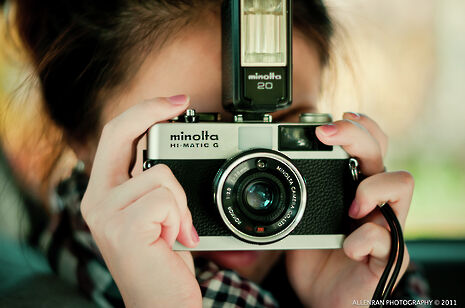The tyranny of the iPhone
After her own jarring experience, Lauren Brown asks whether our photographic obsession is a force for good or mindless apathy

On a sixth-form trip to Auschwitz concentration camp, myself and 15 others quietly crept into a long corridor lined with innumerable, harrowing portraits of past prisoners. For a moment there was silence as we took in the pained expressions or the jarring smiles that shone out from the bleak walls. Then, after this collective intake of breath, cameras and iPhones were promptly retrieved from pockets, wielded, and a wave of clicking commenced. I was baffled at the rush to capture as many of these anonymous faces as possible before we were shuffled along to the next exhibition.
Having snapped a couple of photos myself, I was stung with a sudden twinge of remorse, and when I returned from my trip my family and friends were disappointed to find that, although I had taken photographs, they had all been deleted. Confused, they asked me why – a question that I’m still not fully sure I can answer. I wasn’t planning on uploading to Facebook an uncomfortable and inappropriate album entitled “Auschwitz” (which I have seen, believe me); so why, with these images somehow suspended in my phone, did I feel so strongly that they weren’t mine to possess, to duplicate into further statistical obscurity through an overflow of replica images? Was I honouring this person’s memory by promoting greater awareness of their place in history? Somehow, I felt not. It felt transgressive, wrong. I suppose that there were so many images and that the corridor was so long, on top of all the other sights, that maybe a photograph was a way of condensing it down, making it easier for me to digest. But why should it be easy to digest? Before I knew it, my avid photograph-taking took on a darker shade and the questions cobwebbed and became denser. What does it mean to look at something through an iPhone screen rather than at the thing itself? The concept of endless reproduction, the loss of control or of the meaning of something, be it well-intended or not, seemed terrifying and something I had no rightful authority to do. I realised that using social media in the modern day, in some ways, equated to just that.
Owning these photographs was not an intimate thing, but a crucially mindless click of a button, typifying the way we now communicate through an endless outpouring of images that are quickly swiped away after a fraction-of-a-second's glance. It seemed to be the externalisation of what has become habit rather than a considered response. The problem was not that I had intended to do anything particularly malicious with the image, but that I had simply not thought. It is this reflex reaction that frightens me. I came to realise, as important as the photographs now were in the remembrance and identification of individuals, something I felt this particular exhibition did exceptionally beautifully, that ultimately the situation that gave rise to the photographs should never have happened, and that as a result they were in some way tainted. It forced me to question what it meant to take an image of someone in pain, and then for me to then take a further image of this pain as if I were sadistically duplicating it. Rather than feeling somehow closer to it, I felt distanced, as if I had also somehow diluted the individual stories, removing them from the photographs which were supposed to embolden them. It makes me realise that when looking at something like that we must not only consider the subject, but the person behind the lens as well. Having these images taken by the officers was undoubtedly humiliating, and to replicate the image seemed to somehow unsettle the peace it appeared to have found amongst the many others.
I am torn as to what my role should be. What about the people who weren’t selected to go on the trip, who never got the chance to see these images, these brutal sights? Photography is didactically important, and a crucial tool to inform us of similar atrocities that still occur today. Without the images from refugee camps, for example, we may never know the scale of what is going on, and in this respect photography is absolutely paramount. While capturing pain on a massive scale, a photograph allows this experience to be communicated on an evocatively human level. The implications of dehumanisation through numbers, the loss of the individual in waves of faces is, of course, troublesome: but perhaps this haunting scale is sometimes necessary in order to communicate what the artist is trying to say with her or his work.
Easy access to increasingly large numbers of photographs can be a positive thing. However, we need to seriously consider the mindlessness with which we can so often approach the images we consume. It would be wrong to say that I was ‘lucky’ to have the jolting experience I had, but I feel that it is important for us as individuals to rigorously question the ways in which we are presented with photographs today, and, consequently, to treat them with the delicacy and thoughtful care that they demand. Ultimately, we cannot control everything that we see, or the volume of it: but we retain the ability to both interrogate and appreciate whatever art floods our way.
 Features / How sweet is the en-suite deal?13 January 2026
Features / How sweet is the en-suite deal?13 January 2026 Comment / Will the town and gown divide ever truly be resolved?12 January 2026
Comment / Will the town and gown divide ever truly be resolved?12 January 2026 News / 20 vet organisations sign letter backing Cam vet course13 January 2026
News / 20 vet organisations sign letter backing Cam vet course13 January 2026 Arts / Fact-checking R.F. Kuang’s Katabasis13 January 2026
Arts / Fact-checking R.F. Kuang’s Katabasis13 January 2026 Music / Inside Radiohead’s circle13 January 2026
Music / Inside Radiohead’s circle13 January 2026








